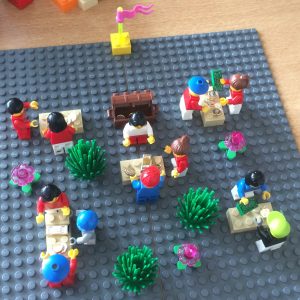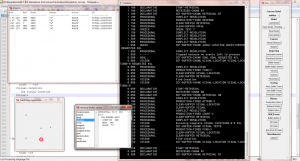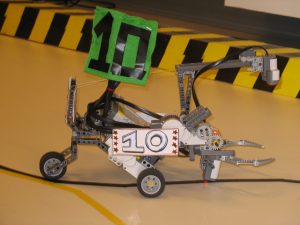
Following a Socratic teaching philosophy, I regard my role as lecturer in supporting and guiding students in the process of developing knowledge and skills. In my opinion, good teaching is defined by being available for my students, embracing their diversity and creating an atmosphere that facilitates individual development and personal growth. By using a portfolio of creative game-based approaches, I foster active engagement and sustainable results and provide opportunities to develop relevant professional qualifications. One of my students’ favorite methods is LEGO Serious Play, which I often use as playful introduction to the core topic of a course.
Teaching at University of Stuttgart
In my current faculty position at the University of Stuttgart, I have the pleasure to educate bachelor, master, and PhD students across various subjects such as data science, computer science, simulation technology, teaching degree, vocational education, and technical education, in a wide range of topics related to digital education, ethical aspects of AI and data in education, child-computer interaction, psychological foundations of teaching and learning, and computer science education.
Within my seminar on AI and data in education, students critically reflect on perspectives and challenges of AI-based systems in educational settings by evaluating case studies and existing technologies. It focuses particularly on related ethical considerations outlined in the “Ethical guidelines on the use of artificial intelligence and data in teaching and learning for educators” that I co-developed, and also introduces relevant legal frameworks. The goal of the seminar is to equip future teachers as well as system designers with the skills and mindset to engage in an informed and reflective use of AI in education.
My introductory lecture on psychological foundations of teaching and learning covers a wide range of topics, ranging from learning and memory, emotion, motivation, embodied cognition and self-regulated learning to serious games, virtual reality, AI in education as well as unconscious stereotypes and biases in learning material. To keep students engaged, I employ a diverse set of didactical approaches, such as videoclips, quizzes, (thought) experiments or active breaks.
In my seminars on digital media and computer science education, building on empirical evidence from instructional design and inspirations from Thiagi, we explore benefits and challenges of different digital tools and approaches for the respective application setting (e.g., computer science lessons in school, vocational training in organizations) together. To equip students with a well-founded didactic toolbox for their future work, they gain hands-on experience by preparing and conducting interactive exercises as part of the seminar. Giving students the opportunity to reflect on their own experiences embeds a powerful momentum of learning in each course.
Teaching at TU Chemnitz

Interactive Learning Media
An important step to address environmental problems in modern societies consists in increasing awareness, which in the long run will also result in behavioral changes. Against the background of education for sustainable development, students in my course “Interactive Learning Media” developed prototypes for digital educational devices that could strengthen sustainability awareness in a catchy and enjoyable way. To provide them with a creative toolbox, I did a workshop on creative thinking, sketching and paper prototyping beforehand. Of course, we also did a LEGO session in the beginning, which resulted in great ideas on the concept of sustainability.
Instructional Psychology
In the very first session of my course “Instructional Psychology”, I asked my students about their expectations on the course. Neither of them had a defined idea of the subject, but when they got the task to build it with LEGO, several relevant topics emerged. A creative story relates to the model on the right border of the picture: “This is Kevin and this is Mathilde. Mathilde is reading books and Kevin is playing video games. Both are competing for the crown of knowledge.”

The course content covered a journey from core theoretical foundations and instructional design models to key features in instructional situations and selected instructional contexts. Each student had the task to co-lecture one of the sessions that always included interactive playful elements. For instance, in one session an “Escape Room” task demonstrated the benefits and challenges of collaborative learning settings, while in another one a complex memory illustrated the concept of element interactivity. From this course, I also got the idea for my guest lecture at the Univerzita Jana Evangelisty Purkyně Ústí nad Labem in Czech Republic, where I introduced selected examples of research from my department related to the topics of the course.
Scripting Exercise
Programming can be a fear-driven subject for students beyond computer science, although it is a useful skill in a broad range of professional fields. To emphasize its value in media and communication science, after providing students with the required “hard skills”, I used a business-inspired collaborative learning paradigm in my “Scripting Exercise”. It put students in the position of market research agencies in a competition for a contract. By applying the previously acquired knowledge themselves, they had the chance to gain a deeper and more sustainable level of skill development. The arising course projects were quite different and each group included a unique special feature.
Statistics Exercise
Understanding the world of statistics has its challenges and is another subject that is acquired best in a learning-by-doing style. Thus, building on the theoretical background knowledge from the related lecture, in my “Statistics Exercise” I taught students how to apply selected basic techniques in statistical data analysis with a mix of teacher demonstration and self-paced group work. For emphasizing the funny side of the subject, I found a website on completely absurd correlations. Did you know that the number of people drowning in a pool substantially correlates with the number of films Nicolas Cage appears in?
Teaching at TU Berlin

Modeling and Simulation in Human-Machine Systems
When I tell people that I do cognitive modeling with the cognitive architecture ACT-R, they usually ask me what it is and why it is useful at all. Well, to quote the website it is “a theory about how human cognition works” and offers the benefit of a programming framework to directly test predictions from this theory. It has been used in a wide range of basic and applied domains that relate to aspects of human cognition. In the course, students were taught the core elements of the architecture in the lecture part, while the exercise part provided hands-on experience with the software. As an exam, students had to develop their own model that could perform a given dual-task. Although ACT-R can be very challenging, they did well and submitted remarkable results.
Courses taught as teaching assistant
Before teaching as a lecturer, I already gained teaching experience as teaching assistant at the Chair of Human-Machine Systems while doing my master’s degree at the TU Berlin. During the “Exercise Human-Machine Systems”, I provided students with theoretical and practical insights on compatibility in human-machine interaction, an essential feature to avoid bad ergonomic design.
The “Interdisciplinary Project in Systems Engineering” offered the possibility to gain applied research experience and establish relevant business contacts in projects with external partners. In this context, I supervised a student group that developed and tested a concept for a mobility-app for cyclists in cooperation with the German Research Center for Artificial Intelligence.

Both the course “Programming for Psychologists” and the “Robotics Project” involved the application of programming-related knowledge in a defined project context. While the first one required students to create an interface for data visualization with the Java-based language Processing, in the second one students built and programmed a LEGO Mindstorms robot that could perform several tasks in a competition. In either course, my responsibility was to teach some basic knowledge and supervise students’ progress in their projects.
